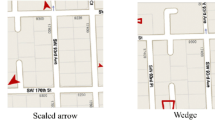Abstract
Maps on mobile devices provide the convenience of accessing spatial information of the surroundings. They also raise the concern that the small screen size impacts user’s acquisition of spatial knowledge as the small size causes the fragmentation of spatial knowledge. This fragmentation leads to the expense of more cognitive efforts and degradation of spatial knowledge. Following some effective approaches of representing distance to off-screen locations as contextual cues, this paper reports a design that incorporates not only the direction but also the distance using symbols. In addition, this study uses three different visual variables including size, color value, and crispness at the ordinal level of measurement and then compares their effectiveness on the perception of distance. Results show that color value contributes the least to the perception of distance. Size leads to slightly higher accuracy than crispness in comparing distances of off-screen landmarks. This study provides valuable information to further explore the impacts of different visual variables that could facilitate the acquisition of spatial knowledge on mobile devices. This study also points out the necessity of follow-up studies to clarify some issues in the current design as well as its impact on actual wayfinding performance.
Access this chapter
Tax calculation will be finalised at checkout
Purchases are for personal use only
Similar content being viewed by others
References
Anacta, V. J. A., A. Schwering, R. Li & S. Muenzer (2016) Orientation information in wayfinding instructions: evidences from human verbal and visual instructions. GeoJournal, 1–17.
Baudisch, P. & R. Rosenholtz. 2003. Halo: a technique for visualizing off-screen objects. In CHI 2003, 481–488. Ft. Lauderdale, Florida, USA.
Burigat, S. & L. Chittaro (2011) Visualizing references to off-screen content on mobile devices: A comparison of Arrows, Wedge, and Overview + Detail. Interacting with Computers, 23, 156–166.
Burigat, S., L. Chittaro & S. Gabrielli. 2006. Visualizing locations of off-screen objects on mobile devices: a comparative evaluation of three approaches. In Proceedings of the 8th conference on Human-computer interaction with mobile devices and services, 239–246. ACM.
Dillemuth, J. (2005) Map design evaluation for mobile display. Cartography and Geographic Information Science, 32, 285–301.
Gollenstede, A. & M. Weisensee. 2014. Animated cartographic visualisation of networks on mobile devices. In 11th International Symposium on Location-Based Services, 26–28. Vienna, Austria.
Gustafson, S., P. Baudisch, C. Gutwin & P. Irani. 2008. Wedge: clutter-free visualization of off-screen locations. In CHI 2008, 787–796. Florence, Italy.
Gustafson, S. & P. Irani. 2007. Comparing visualization for tracking off-screen moving targets. In CHI 2007, 2399–2404. San Jose, California, USA: ACM Press.
Harrower, M. & C. A. Brewer (2003) ColorBrewer. org: an online tool for selecting colour schemes for maps. The Cartographic Journal, 40, 27–37.
Irani, P., C. Gutwin & X. D. Yang. 2006. Improving selection of off-screen targets with hopping. In CHI 2006, 299–308. Montreal, Quebec, Canada: ACM Press.
Ishikawa, T. & M. Kiyomoto. 2008. Turn to the left or to the west: Verbal navigational directions in relative and absolute frames of reference. In GIScience 2008, 119–132. Springer.
Li, R., A. Korda, M. Radtke & A. Schwering (2014) Visualising distant off-screen landmarks on mobile devices to support spatial orientation. Journal of Location Based Services, 8, 166–178.
Li, R. & J. Zhao (2016) Resizing off-screen landmarks on mobile devices: Levels of measurement and the perception of distance. Manuscript submitted for publication.
Lovelace, K. L., M. Hegarty & D. R. Montello. 1999. Elements of good directions in familiar and unfamiliar environments. In Spatial Information Theory: Cognitive and Computational Foundations of Geographic Information Science 1661, 65–82.
MacEachren, A. M. 1995. How Maps Work: Representation, Visualization, and Design. New York, NY, USA: Guilford Press.
Michon, P.-E. & M. Denis. 2001. When and Why Are Visual Landmarks Used in Giving Directions? In Spatial Information Theory, ed. D. R. Montello, 292–305. Heidelberg: Springer.
Münzer, S., Zimmer, H. D., Schwalm, M., Baus, J., & Ilhan, A. (2006). Computer-assisted navigation and the acquisition of route and survey knowledge. Journal of Environmental Psychology, 26, 300–308.
Parush, A., S. Ahuvia & I. Erev. 2007. Degradation in spatial knowledge acquisition when using automatic navigation systems. In Spatial information theory, 238–254. Springer.
Plaisant, C., Carr, D., Shneiderman, B., 1995. Image-browser taxonomy and guidelines for designers. IEEE Software, 12, 21–32.
Raper, J., G. Gartner, H. Karimi & C. Rizos (2007) A critical evaluation of location based services and their potential. Journal of Location Based Services, 1, 5–45.
Raubal, M. & S. Winter. 2002. Enriching wayfinding instructions with local landmarks. In Geographic Information Science, eds. M. J. Egenhofer & D. M. Mark, 243–259. Springer.
Robinson, A. H., J. L. Morrison, P. C. Muehrcke, A. J. Kimerling & S. C. Guptill. 1995. Elements of Cartography Sixth Edition John Wiley & Sons. Inc.
Schmid, F. (2008) Knowledge based wayfinding maps for small display cartography. Journal of Location Based Services, 2, 57–83.
Speake, J. & S. Axon (2012) “I Never Use ‘Maps’ Anymore”: Engaging with Sat Nav Technologies and the Implications for Cartographic Literacy and Spatial Awareness. The Cartographic Journal, 49, 326–336.
Waters, W. & S. Winter (2011) A wayfinding aid to increase navigator independence. Journal of Spatial Information Science, 2011, 103–122.
Willis, K. S., C. Hölscher, G. Wilbertz & C. Li (2009) A comparison of spatial knowledge acquisition with maps and mobile maps. Computers, Environment and Urban Systems, 33, 100–110.
Winter, S., M. Tomko, B. Elias & M. Sester (2008) Landmark hierarchies in context. Environment and Planning B: Planning and Design, 35, 381–398.
Author information
Authors and Affiliations
Corresponding author
Editor information
Editors and Affiliations
Rights and permissions
Copyright information
© 2017 Springer International Publishing AG
About this paper
Cite this paper
Li, R. (2017). Effects of Visual Variables on the Perception of Distance in Off-Screen Landmarks: Size, Color Value, and Crispness. In: Gartner, G., Huang, H. (eds) Progress in Location-Based Services 2016. Lecture Notes in Geoinformation and Cartography(). Springer, Cham. https://doi.org/10.1007/978-3-319-47289-8_5
Download citation
DOI: https://doi.org/10.1007/978-3-319-47289-8_5
Published:
Publisher Name: Springer, Cham
Print ISBN: 978-3-319-47288-1
Online ISBN: 978-3-319-47289-8
eBook Packages: Earth and Environmental ScienceEarth and Environmental Science (R0)




